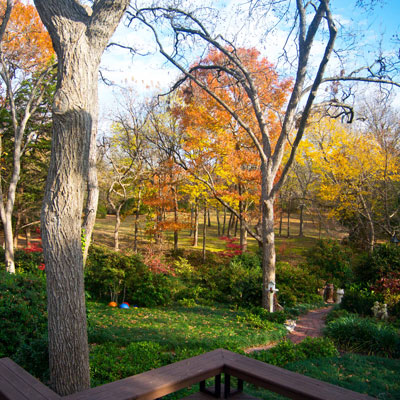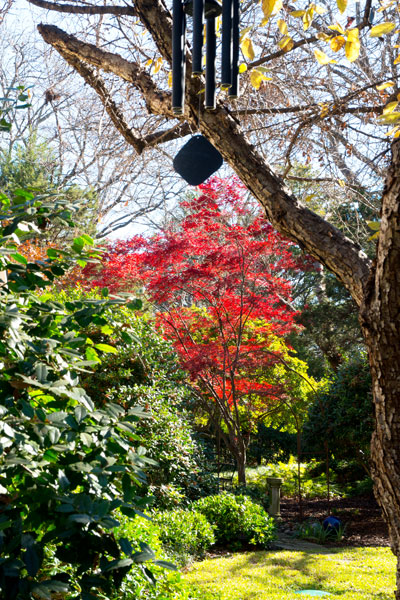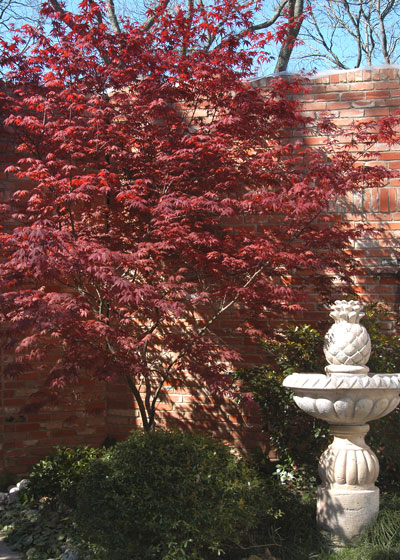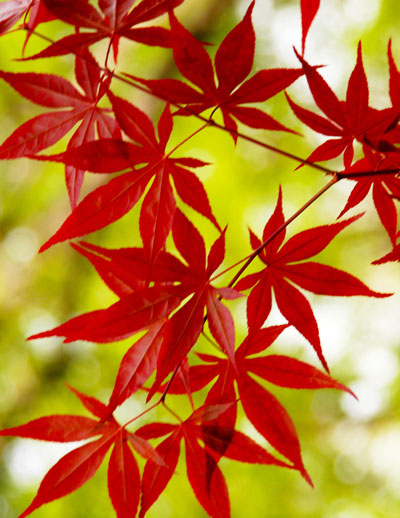Plant of the Week: Japanese Maples
We live in a pecan forest in rural Collin County (northeast of Dallas). There are almost no spots of direct sun anywhere in our landscape. That means that the trees, shrubs, vines and groundcovers I grow are going to have to handle the shade and still grow without complaining.

Japanese maples are the small spots of color in Sperry backyard in autumn. Across the creek are red oaks, elms and ashes. Click photo for a larger view.
When I want some kind of exclamation point in a spot with high visibility, I think first of Japanese maples. They’re about as pretty as a small, shade-tolerant tree can be. And, my wife loves them. I’m a prudent man, so most of my nursery buying sprees end up with a new tree for my marriage.

Bloodgood Japanese maples are intensely colorful in spring and fall. In between they hold their red leaf color better than most.
As I get out of my truck at the nursery, I promise myself that this time I’ll find some variety other than ‘Bloodgood.’ But remembering how much she loves them through the spring, summer and fall, I always succumb. Bloodgoods make up a major part of our plantings.
The Basics…
But I’ll keep it more generic, covering only the important facts on this great group of small trees.
• There are several hundred varieties of Japanese maples. Some are green. Many are maroon-red. The better independent retail garden centers along and east of I-35 (the part of Texas where they’re best adapted) will offer a dozen or more types.
• Japanese maples must have shade. We have about 20, and there isn’t one that sticks out into the sun for more than a few minutes each day.

This is my second-oldest Japanese maple. It flanks my office and a walk down to the Santa barn.
• Japanese maples must be kept uniformly moist. These trees are from parts of Japan where temperatures rarely go above 80 to 85F. But we do go above those balmy readings here in Texas, so we counteract the temperatures by keeping our trees in the shade and moist. And we avoid high-nitrogen, lawn-type fertilizers during the heat of the summer for the same reason. Spring and fall feedings will be sufficient.

Back-lighting works wonders with Japanese maple foliage. This is the view out one of our windows while the trees are brilliantly colorful.
• Japanese maples are winter-hardy clear to the Canadian border, and that means that they can be grown outdoors in patio pots 12 months a year.
If you’re in a part of Texas where Japanese maples do well, they’re a grand addition to your gardens.
This story ran originally in e-gardens March 24, 2016. I’ve chosen to use it again because (a) I still like it and (b) vertigo says it’s time to step away from the computer. Hope you enjoyed it!
